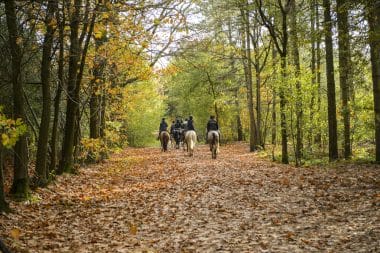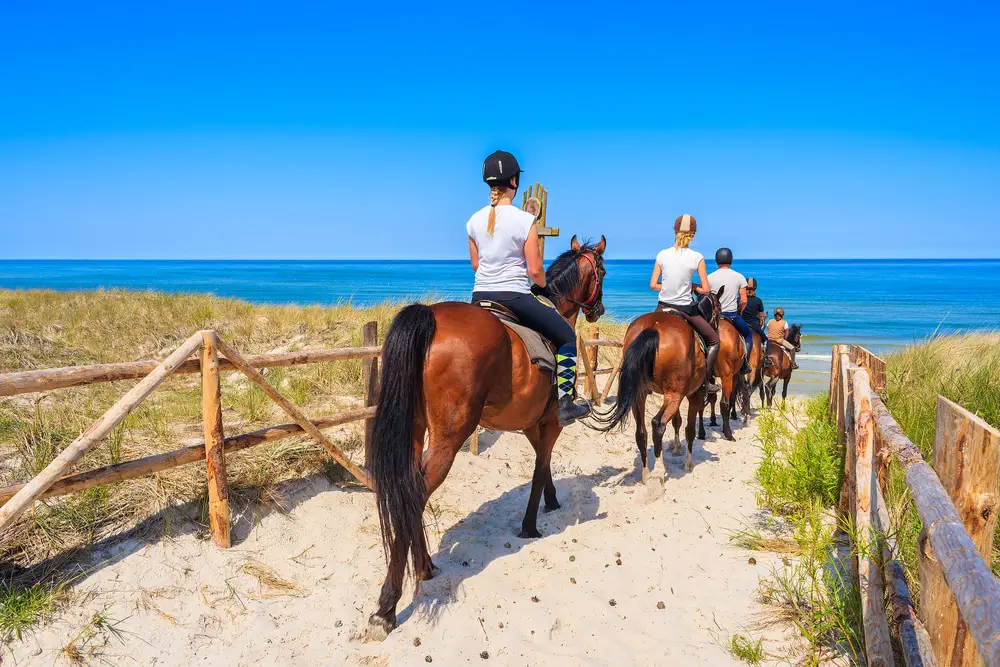The much-quoted Arabic proverb, according to which happiness on earth lies on the back of a horse, is also ideally suited to poetically explain the great popularity of riding holidays and riding trips. For passionate horse lovers, there can of course be no better holiday than the one with their declared favourite animal.
But not only for professional riders, the journey on horseback through unknown realms is a unique and unforgettable experience. Even for beginners interested in hipposcience, a riding holiday at the riding stable is often the prelude to a lifelong passion.
In practice, riding holidays and riding tours are usually differentiated by commercial providers and tour operators according to the type of stay or course: For already experienced riders, the so-called trail riding lasting several days with daily distances of up to approx. 30 kilometres in a maximum of 8 hours is particularly recommended, during which longer distances are covered and a different place is spent every night.
On the other hand, stationary riding holidays are more leisurely and leisurely, where in addition to daily rides on local and regional bridle paths in the surrounding area and learning the basic gaits, the focus is also on the most important grooming techniques such as feeding, leading, saddling and grooming.
The two undoubtedly internationally best-known destinations for riding holidays of all kinds are the USA and Canada, where horses still play an important role in everyday life and economic life, some of them regionally and much more so than in Europe. Nevertheless, there are also many magical places, areas and areas on the “Old Continent” for an all-round successful riding holiday. Depending on the equipment and type of accommodation or duration of the riding holidays, a week’s riding holiday in Germany and other European countries currently costs between about 350 and 800 euros per person.
Riding holidays and riding tours in Germany
There is a large selection of riding stables and trail riding trails throughout Germany, but most of the stations and routes are in Bavaria, Baden-Württemberg, Hesse, Rhineland-Palatinate and in the “horse country” of Lower Saxony. Particularly popular with families with children are the scenic and varied regions around Lake Constance and the Black Forest, Franconian Switzerland and Upper Palatinate in northeastern Bavaria as well as the many traditional riding stables in Lower Saxony along and near the North Sea coast and in the Lüneburg Heath. A famous long-distance bridle path is the 386.8-kilometre-long “German Equestrian Trail No. 1” between Flensburg and Basel. For excursions on a riding holiday, the respective main and state studs with their regular stallion parades and carriage demonstrations are also ideal. The institutions, some of which are centuries old, are located in Redefin (Mecklenburg), Zweibrücken (Rhineland-Palatinate), Celle (Lower Saxony), Warendorf (North Rhine-Westphalia), Moritzburg (Saxony), Dillenburg (Hesse), Schwaiganger (Bavaria), Neustadt/Dosse (Brandenburg) and Marbach (Baden-Württemberg).
Horse riding holidays and horseback riding tours in France
Within Europe, France is considered by connoisseurs to be the country for horse lovers. This is evidenced not least by the inclusion of the French equestrian tradition in the United Nations’ list of the Intangible Cultural Heritage of Humanity in 2011. As early as the late 16th century, the internationally used word “cavalry” for mounted military was derived from the French term “cavalerie”. As the world’s largest exporter of horses, France owes its high national standards in equestrian sports to the military riding school “Cadre Noir” in Saumur (Pays de la Loire), founded in 1828. At Le Pin-au-Haras National Stud Farm (Normandy), 40 percent of all French racehorses and 30 percent of all French sport horses are bred. Horseback riding holidays are offered throughout the country, there are about 8,600 equestrian clubs, 5,000 equestrian centers and 400 equestrian tourism centers. Among the most popular regions for trail riding are the Camargue, Côte d’Azur (Provence) and Pyrenees in the south and southwest as well as the Vosges in Alsace in the northeast.
Riding holidays and riding tours in Spain and Portugal
Spain and Portugal have historically played equally important roles in the spread of equestrian practice in Europe. On the Iberian Peninsula, horses were already known in the Paleolithic Age. They finally became familiar pets and farm animals through the rule of the North African Moors over the country from the 8th to the 15th century, who used the animals both in agriculture and in the military. Horse lovers know the typical Iberian horsemanship under its name “Doma Clásica”. This discipline, which dates back to the Baroque period, is still taught at the “Royal Andalusian Riding School” in Jerez de la Frontera near Cadiz and the “Portuguese School of Equestrian Art” in Belém near Lisbon . However, their classic gaits such as the “Spanish walk” (emphasized lifting of the front hoof) and “Spanish step” (passengers) are by no means necessary for riding holidays in Spain and Portugal. Most of the offers for great riding holidays in front of a fantastic scenic backdrop can be found in the Algarve in the south of Portugal as well as on the Costa del Sol and Costa de la Luz in Andalusia, where the world-famous horse breed “Andalusian” also comes from.
Horse riding holidays in Great Britain and Ireland

English and Irish history books alike are filled with epic tales and heroic sagas of victorious battles in which knights armed to the teeth on horses defeated all sorts of enemies. Given this proud heritage, which is also reflected in the UK’s enthusiasm for horse racing and horse betting, it’s no surprise that both the UK and Ireland each have plenty of great deals on horse holidays. Numerous raving reports from holidaymakers about breathtaking horseback rides praise the coastal sections of Cornwall and Wales in particular. The Dartmoor and Exmoor National Parks in the counties of Somerset and Devon in the southwest of the United Kingdom are also popular and frequent with horses. On the east coast of England near Newmarket (Suffolk) lies “The National Stud”, a time-honoured thoroughbred horse breeding farm. In Ireland, the provinces of Antrim, Cork, Clare, Mayo as well as the Burren, Connacht, Dublin, Munster and the surrounding area of Westport enjoy an excellent reputation for equestrian holidays.
Iceland and Sweden
As one of the most sparsely populated regions in Europe, Scandinavia inspires its guests with picturesque and in many places still almost untouched natural landscapes. Here, as centuries ago, you are almost alone on horseback along wild rivers, dark lakes and endless forests. Throughout Sweden , riders have hundreds of kilometres of specially marked routes (“ridled”) at their disposal for trail riding. Among the most used trails are those through the Tiveden National Park (Örebro County), in the vicinity of Tidaholm (Västra Götaland Province) and the routes in the southern province of Småland. A ride on the rather small, but robust and muscular Icelandic horse is undoubtedly a special experience for every riding enthusiast. It is true that the prices for two- to eight-day riding holidays with excursions past steaming geysers and majestic volcanoes in Selfoss (Árborg), Hvolsvöllur, Hvammur, Þingvellir, Þjórsá, Skagafjörður and Varmahlíð are significantly higher than in the rest of Europe. However, riders also see fairytale landscapes that cannot be found anywhere else in the world.


